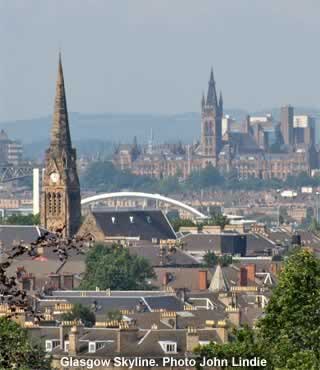Glasgow |
|
 |
|||
Scotland's largest city and the industrial hub of this northern nation |
Listen to this article |
Glasgow or Glaschu in Scottish Gaelic is Scotland's largest city and the industrial hub of this northern nation. With Greater Glasgow having a population of over a million, it is the third most populated city in the United Kingdom. Like many of the world's major settlements, Glasgow is built upon the banks of a major river, the Clyde, and is situated in the west central lowlands. Whilst Edinburgh may be seen as the cultural centre of Scotland, Glasgow is where Scottish industrial muscle is flexed. It is now the centre of Scotland's economy and the driving force behind the country's growth, both socially and economically. |
It was the settlement's strategic location at a downriver ford of the river Clyde that led to its original establishment. People quickly settled in the area in prehistoric times as it was a popular site for salmon fishing. By the early medieval period the district had become a Bishopric which went on to become one of Scotland's largest and most wealthy. Then, in the 12th century, Bishop Jocelin obtained 'burgh' status from the King and Glasgow grew as a centre of trade. It wasn't until the 18th century though that the city really established itself as the industrial giant of Scotland. The 1707 Acts of Union further united England and Scotland and so the city became a major port, trading throughout the British Empire. Tobacco, sugar and cotton were all transported via the deep water port. The textile industry then bloomed out from this success and Glasgow became the Empire's Second City. Whilst the city went from industrial strength to industrial strength in the 19th century, the 20th century was less kind. The ravages of war, economic depression and overseas competition led to a decline in industry and subsequent urban decay. Investment since the 1980's however, has turned the fortunes of this vibrant city around and Glasgow has now established a strong reputation for business, finance and tourism. |
This up and down history has led to Glasgow developing a fascinating architectural heritage. Few medieval buildings are left, but St Mungo's Cathedral is worth a visit, with wonderful gothic design and ornate features. The wealth of the industrial boom led to engineering masterpieces such as the Loch Katrine aqueduct, the Subway and tramway systems, the Kelvingrove Art Gallery and Museum, the Mitchell Library and the impressive City Chambers. These stunning buildings are a testament to a past age and provide Glasgow with a visual energy rarely found. It was this aesthetic beauty that led Daniel Defoe in the 1700's to coin Glasgow as "the cleanest and beautifullest, and best built city in Britain, London excepted". Charles Rennie Mackintosh, world famous architect and proponent of British art nouveau was born in Glasgow in 1868 and his designs add yet more to the skyline of the city. Queen's Cross Church is a Macintosh gem and will delight any fan of art nouveau. At Mackintosh House one can see a painstakingly reconstructed view of the interior designs of his home. |
Unfortunately, the economic slump of the mid 20th century led to an era of oppressive inner city tower blocks and 1960's monstrosities. More recent urban rejuvenation has bought a new wave of architecture to the city outdating it's unfair label as a city of depravity. For example, there are the structures of the Clyde Waterfront regeneration project and the Royal Concert Hall. Perhaps most famous of all though is the Clyde Auditorium designed by the British architect Sir Norman Foster, famous for his reconstruction of Berlin's Reichstag. The Clyde Auditorium is known as the 'Armadillo' and is a truly unique and exciting structure resembling a scaly beast. Few cities in the world have such a wonderful array of buildings and Glasgow's architectural prowess was celebrated in 1999, when the city was awarded the UK City of Architecture and Design. This ever changing urban landscape can be celebrated at 'The Lighthouse', Scotland's Centre for Architecture and Design. |
Glasgow is also home to the leafy Kelvingrove Park, The Museum of transport, galleries such as The Lillie Art and McLean and the M&D theme park. Merchant Square adds yet more Victorian style and is home to a wonderful collection of bars and restaurants. |
Emerging from a less kind reputation, Glasgow is undoubtably a remarkable place, considered by Lonely Plant to be one of the world's top 10 cities. It's buildings are a window into its varied past. Few other cities have such a raw feel, such a thin line between architecture and society. The unusual buildings on so many a street corner and the smorgasbord of design treasures help define the city and its people, even the tower blocks and old factories add interest to the cityscape; a visual marker of tougher times. |
Whilst many assume Edinburgh to be the nation's major destination of choice, make sure you don't miss out on the opportunity to discover a more edgy city, full of interest, passion and energy. Glasgow is true Scotland and at its most eclectic! |
|
Pocket Britain is optimised for use on a smartphone or tablet with internet access. All content is subject to copyright. All reasonable methods have been used to ensure information supplied is accurate at the time of publication. However, it is advisable to check information before relying on it. Privacy Policy |